#myriapods
Explore tagged Tumblr posts
Text
Giant Emerald Pill-Millipede: when these enormous millipedes are all rolled up, their bodies can be as big as a baseball, a tennis ball, or a small orange
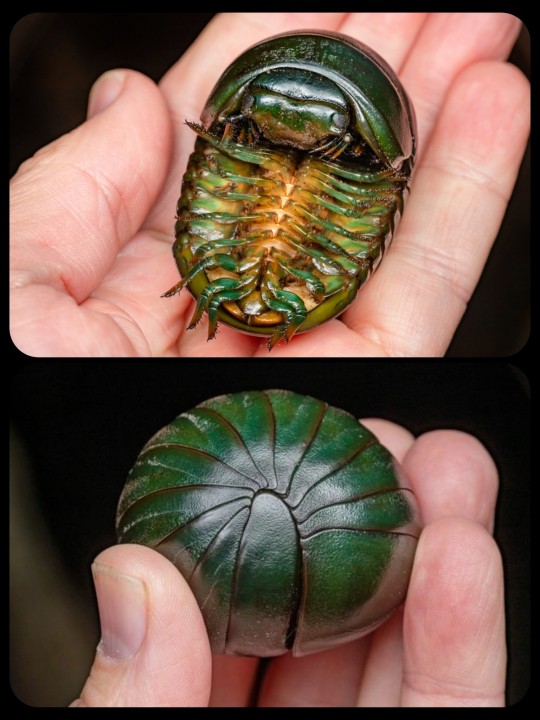
This species (Zoosphaerium neptunus) is commonly known as a giant emerald pill-millipede. The females can measure up to 90mm long (roughly 3.5 inches), making this the largest species of pill-millipede in the world.

There is a significant degree of sexual dimorphism in this species, with the males measuring only about 45mm (1.8 inches) long -- roughly half the size of the females.
Giant emerald pill-millipedes are found only in Madagascar, which is home to several endemic species of giant pill-millipedes (order Sphaerotheriida). The Malagasy name for giant pill-millipedes is "Tainkintana," which means "shooting-star."

Pill-millipedes use conglobation as a defense mechanism, which means that they can curl their bodies up into a spherical shape so that their dorsal plates form a protective shield around the softer, more vulnerable parts of their bodies, just like an actual pill-bug or a "roly-poly."
When they roll themselves up completely, they look almost like gently polished chunks of malachite, emerald, or jade.
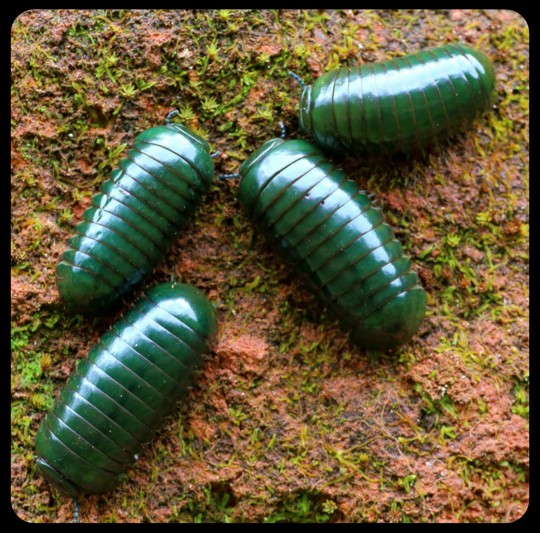
Giant emerald pill-millipedes will sometimes form large swarms that travel together as a group. This is the only species of giant pill-millipede that engages in any sort of swarming behavior, and the purpose of that behavior is still unclear. The swarms often contain thousands of individuals, with almost all of them moving in the same direction, even when there is no physical contact that might allow the millipedes to "herd" one another along.
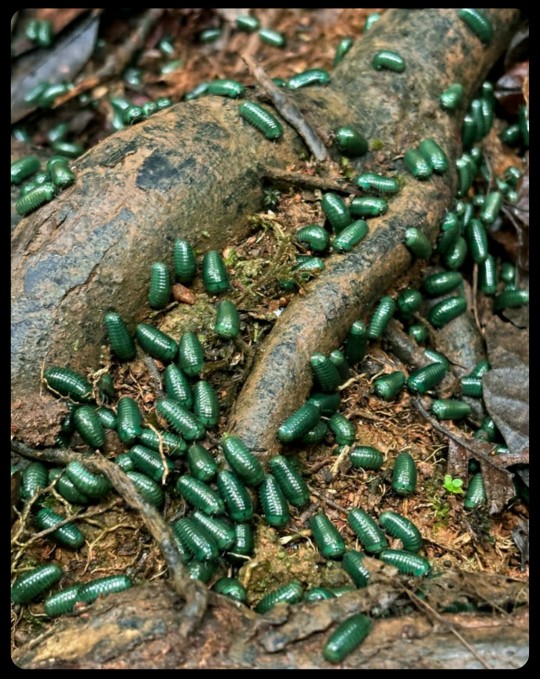
Their swarming behavior also has some very peculiar features, as this article explains:
During swarming, Zoosphaerium neptunus individuals pay little attention to their surroundings; many specimens were observed walking straight into and drowning in small puddles. Some swarms even display ‘cliché lemming behaviour:' in Marojejy, a large part of a swarm walked into and drowned in a small river.
No single specimen was observed walking ‘against the current,' all specimens were moving in the same direction (southeast), even when not in contact with one another.
Of 273 randomly collected individuals, 105 were males, while 168 were females. The males were 8.3 - 14.1 mm wide (average width 10.4 mm). According to the inner horns of the posterior telopods, all males were sexually mature. The females were 9.95 - 15.4 mm wide (average width 11.4 mm). All females displayed non sclerotized vulvae and were sexually immature.
Some researchers argue that the swarming serves as a defense mechanism, providing a layer of protection (or at least some cryptic cover) against local predators, but the swarming behavior is still poorly understood.

Important Note: I just want to remind everyone that these animals belong in their own natural habitat -- they should not be trapped, bought/sold, traded, shipped, collected, or kept as pets. This particular species does not survive well in captivity, either, and the demand for these "exotic" invertebrates is putting the wild populations in jeopardy. The previous article discusses those issues, too:
Another possible threat for Z. neptunus swarms are collections for the pet trade. There exists a large demand in Japan, Europe and North America for 'green -eyed monsters’ as pets. Giant pill -millipedes from Madagascar unfortunately have a very short survival time in terraria. The species is specialized on low-energy food (dead leaves), and adapted to the cool climates (<20°C) of the highlands. Specimens in terraria often starve to death quickly.
So I know that they're adorable and really, really fascinating...but let's just let them be their chunky, adorable little selves out in the wild where they belong.
Sources & More Info:
European Journal of Taxonomy: Seven New Giant Pill-Millipede Species and New Records of the Genus Zoosphaerium from Madagascar
Madagascar Conservation & Development: Swarming Behavior in the World's Largest Giant Pill-Millipede, Z. neptunus, and its Implication for Conservation Efforts
Bonn Zoological Bulletin Supplementum: The Giant Millipedes, Order Sphaerotheriida (an Annotated Species Catalogue) (PDF)
African Invertebrates: Madagascar's Living Giants: Discovery of Five New Species of Endemic Giant Pill-Millipedes from Madagascar (PDF)
#arthropods#giant green pill-millipede#zoosphaerium neptunus#myriapods#diplopoda#millipedes#island gigantism#entomology#evolution#malagasy#cool animals#bugs#insects#animal facts#madagascar#pill-millipede#pill bugs#but not really#Tainkintana#conglobation#swarming#conservation#giant emerald pill-millipede
10K notes
·
View notes
Text
Brachycybe rosea
#inaturalist#naturalist#nature#ecology#zoology#biology#wildlife#bug#bugblr#entomology#bugs#invertblr#invert#invertebrates#inverts#myriapod#myriapods#millipede#millipedes#photography#nature photography#wildlife photography#hawks photos#animal photography
5K notes
·
View notes
Text

Harold the house centipede ✨
#she is Denny and Alex's pet#she can talk but they don't know that#art#illustration#ocs#novel stuff#bugs#myriapods#centipedes#house centipede#artists on tumblr
6K notes
·
View notes
Text

HEYYYYYYYYY HELLO HI HIIIII ^_^ !!!!!!
#the soil centipede that is so very happy to see you#myriapods#centipede#soil centipede#bug cw#not art
2K notes
·
View notes
Text
THE CENTIBEAD


[ID: a Scolopendra centipede made out of pony beads, using the same techniques one would use to make a bead lizard]
#words words words#i'm so insanely proud of this#i came up with the pun AFTER making it#centibead#kandi#centipede#scolopendra#myriapods
856 notes
·
View notes
Text
BABY CENTIPEDE 🥹

3K notes
·
View notes
Text
Stole @littlewigglers gigantic millipede for walkies

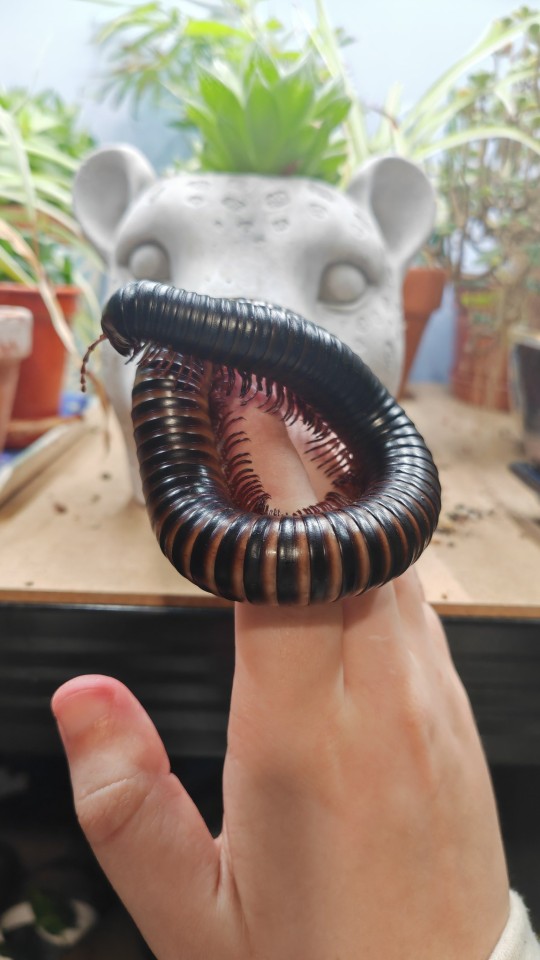
Giant african millipede - Archispirostreptus gigas
404 notes
·
View notes
Text
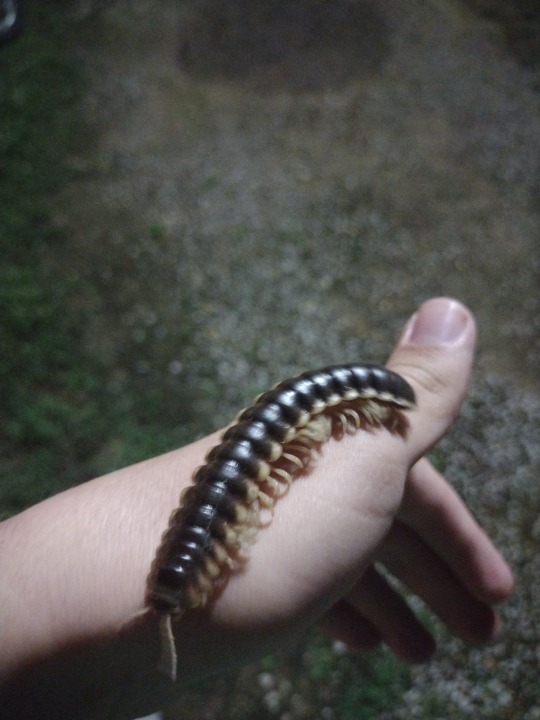
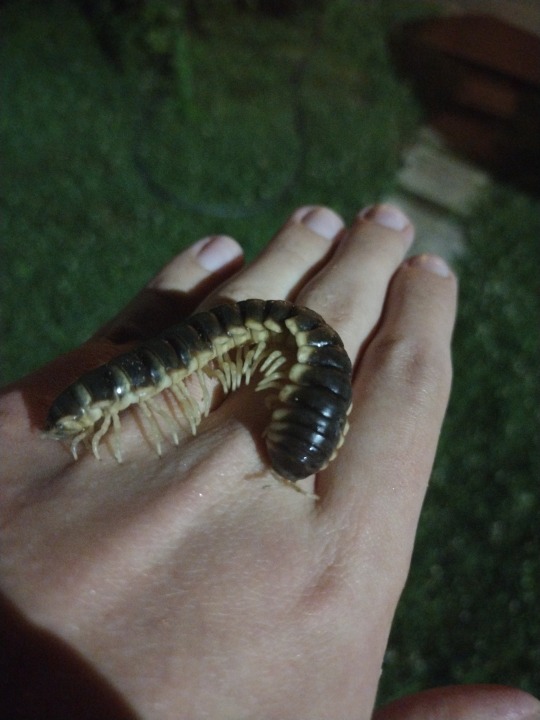


[PHOTOS TAKEN: JUNE 3RD, 2024 | Image IDs: Four photos of a large, black and beige Xystodesmid millipede on a human hand, illuminated by an outdoor light in the night /End IDs.]
One of the biggest and most beautiful millipedes I've seen! Likely only second to the American Giant in terms of what I've encountered- Absolutely fascinating! Not to mention strange to feel walking on your skin
#millipedes#millipede#diplopoda#myriapods#myriapod#arthropods#bug#bugs#Bugblr#invertebrates#Inverts#photo#photos#Wasp House Sights#Xystodesmidae
650 notes
·
View notes
Text
today's invertebrate.......alipes multicostis
quick question do you like centipedes???? because alipes multicostis only talks to people who like centipedes
alipes multicostis is the leader of the "popcorn eatin goons" club, which has 40 members. they eat copious amounts of popcorn every august 16th, which is why they're named the "popcorn eatin goons"
she also likes diving in warm seas to meet up with her best buddy eupolyodontes!!! that's why her back legs are like that! (pics by frupus https://www.flickr.com/photos/frupus/)
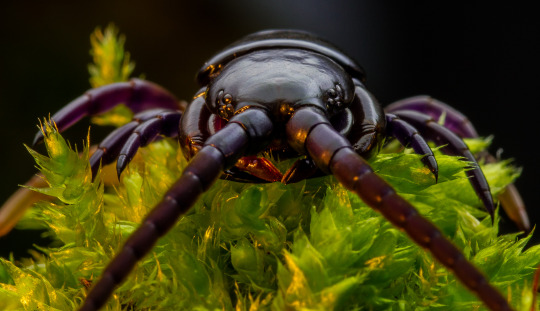


527 notes
·
View notes
Text



little buddy
#augh i love them#so much#little babies#my babies#bugposting#bumblebee millipede#millipede#🐝#millipedes#bug#bugblr#bugs#myriapod#myriapods#invertebrate#invertebrates#invertblr
279 notes
·
View notes
Text
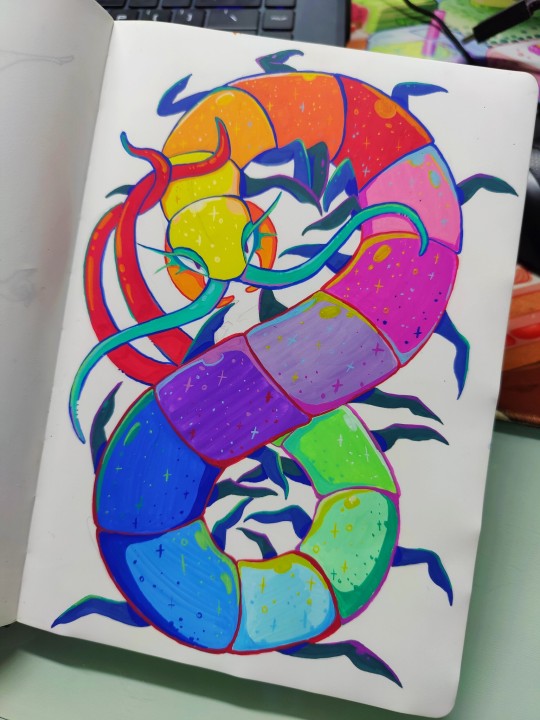
Do you love the colour of the centipede?
766 notes
·
View notes
Text
Brachycybe producta
#inaturalist#naturalist#nature#ecology#zoology#biology#wildlife#insect#insects#bug#bugblr#entomology#bugs#insectblr#photography#nature photography#wildlife photography#hawks photos#animal photography#myriapod#myriapods#millipede#millipedes#invertebrates#arthropods#invertiblr
3K notes
·
View notes
Text

A short-tailed mamushi (Gloydius brevicauda) preys on a Chinese red-headed centipede (Scolopendra mutilans) in Korea
by Jean-Jacques Strydom
#short tailed mamushi#vipers#snakes#reptiles#gloydius brevicauda#gloydius#viperidae#serpentes#squamata#reptilia#chordata#chinese red headed centipede#centipedes#myriapods#scolopendra mutilans#scolopendra#scolopendridae#scolopendramorpha#chilopoda#myriapoda#arthropoda#wildlife: korea#wildlife: asia#predation#animal death
210 notes
·
View notes
Text


spare a thought for this poor naive Lithobius who, in its panic and hubris, allowed itself to be scooped up by a leaf and dangled in front of me so i could get a look at its ridiculous face and forcipules. no more running for you, let alone scuttling or even skittering
(March 15th, 2025)
105 notes
·
View notes
Text
an american giant millipede (a Narceus species in the americanus/annularis complex) traversing a lichen-covered boulder on a mountaintop (Massachusetts, 8/7/23)
Sometimes referred to as “iron worms”, these large millipedes are often locally abundant in mature forests and mountainous areas in the northeastern US. They spend most of their time hidden in decayed logs and leaf litter but regularly emerge to wander in the open, climbing rocks and trees to graze on lichen. Protected by toxins that deter most predators, they do so even in broad daylight, especially during wet or cloudy weather.
2K notes
·
View notes